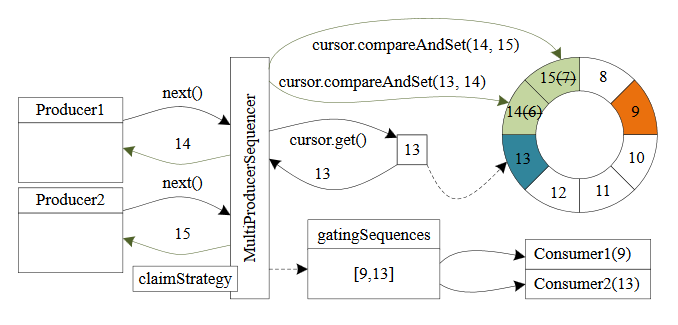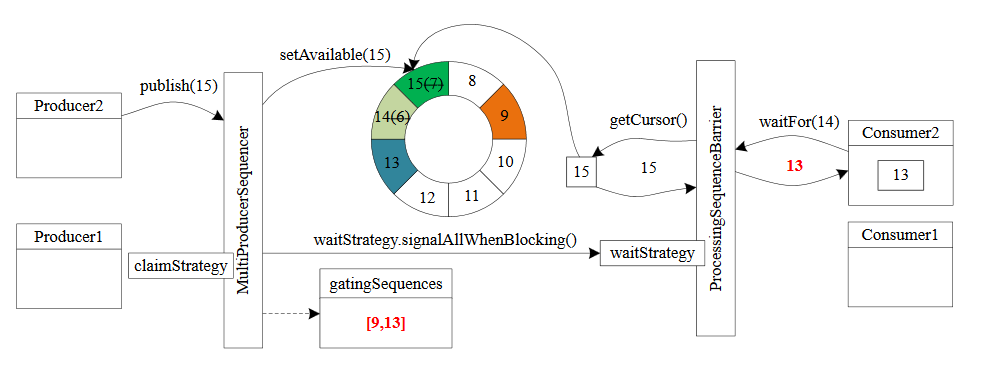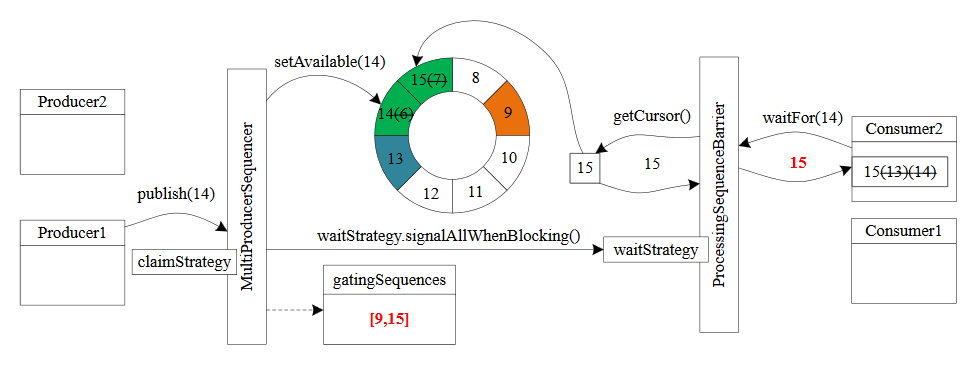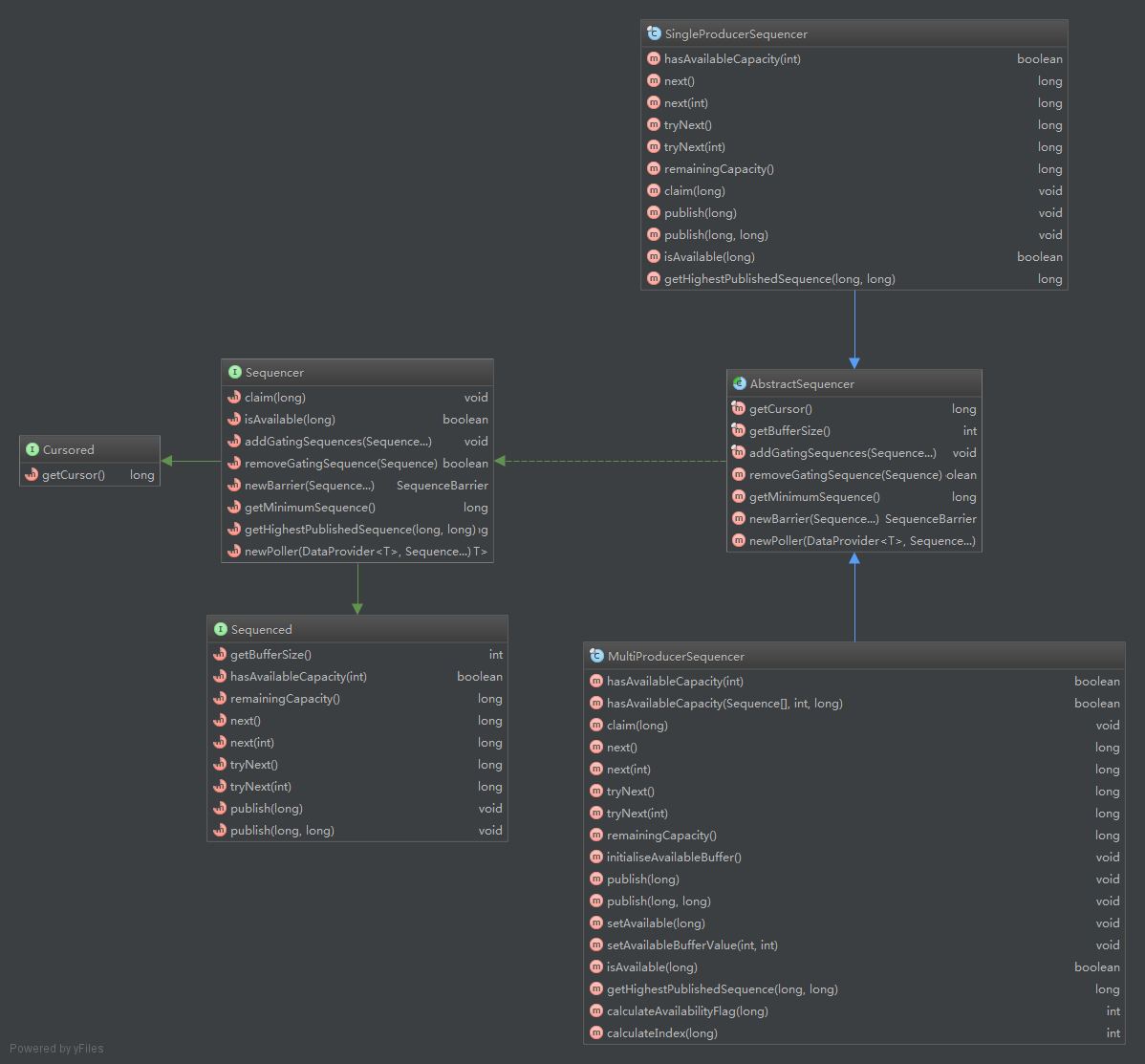Previous chapter This chapter mainly introduces how a single producer writes data to RingBuffer data, how not to make rings overlap, notify consumers after writing, batch processing at one end of the producer, and how multiple producers work together. This chapter mainly introduces how multiple producers write data to RingBuffer data.
1. The MultiProducerSequencer requests the next node

Unlike the single producer, the next method directly sets the sequence of the producer's cursor cursor through the cursor.compareAndSet(current, next). You may ask whether consumers can obtain data in the multi producer scenario after setting the producer's cursor and before submitting data. The answer is No. the method of getHighestPublishedSequence implemented by MultiProducerSequencer is different from that of a single producer, which will be explained in detail later.
2. Multi producer MultiProducerSequencer submits data
The difference from a single producer is to use setAvailable to set the data to an available state.
In the case of multiple producers, other things are needed to track the serial number. This serial number refers to the currently writable serial number. Note that this is different from "add 1 to the cursor of RingBuffer". If you have more than one producer writing to RingBuffer at the same time, some entries may be written by the producer but not submitted.
Producer 1 gets serial number 14 and producer 2 gets serial number 15. Now suppose that producer 1 did not have time to submit data for some reason.
Producer 2 requests to submit data through setAvailable(15), as shown in the figure.

At this time, when the consumer passes waitFor(14), the returned result will be 13, which is good for any event processing.
When producer 1 completes submitting data through setAvailable(14), as shown in the figure.

The run implementation of BatchEventProcessor will process the data at positions 14 and 15, and obtain the available data through waitFor(16) next time.
3. Musiproducersequencer producer class diagram.

-
Musiproducersequencer inherits AbstractSequencer and implements the Sequencer interface.
-
Sequencer provides adding and deleting consumer sequences, creating SequenceBarrier, and obtaining the minimum sequence number and the maximum published sequence number.
-
Cursored gets the current cursor.
-
Sequenced get the current ringbuffer size, get a sequence number, and submit the data interface.
The relationship between consumers and producers is the same as that of a single producer.
4. Multiple producers obtain the next available serial number through next
public long next(int n) {
if (n <1) {
throw new IllegalArgumentException("n must be > 0");
}
long current;
long next;
do {
// ringbuffer current producer cursor
current = cursor.get();
// Next available sequence number
next = current + n;
// Overlapping point position
long wrapPoint = next - bufferSize;
// Sequence number of cached consumer processing
long cachedGatingSequence = gatingSequenceCache.get();
// wrapPoint > cachedGatingSequence,
// The overlapping position is greater than the sequence number of the cached consumer processing, which indicates that some consumers have not completed the processing and cannot prevent the data
// cachedGatingSequence > nextValue
// Only in https://github.com/LMAX-Exchange/disruptor/issues/76 In case of
if (wrapPoint > cachedGatingSequence || cachedGatingSequence > current) {
// Get the smallest sequence number of consumers and producers
long gatingSequence = Util.getMinimumSequence(gatingSequences, current);
// Still overlap
if (wrapPoint > gatingSequence) {
// Notify the consumer to handle the event
waitStrategy.signalAllWhenBlocking();
// After the producer waits for spin, the subsequent strategy needs to be used
LockSupport.parkNanos(1);
continue;
}
// If there is no overlap, set the consumer cache
gatingSequenceCache.set(gatingSequence);
}
// Without overlap, set the sequence number of RingBuffer directly to next
else if (cursor.compareAndSet(current, next)) {
break;
}
}
while (true);
// Returns the available sequence number
return next;
}
5. Multiple producers submit data through publish
public void publish(final long sequence) {
// Set sequence to available state
setAvailable(sequence);
// Notify the consumer to handle the event
waitStrategy.signalAllWhenBlocking();
}
Multiple producers have set cusor in the next method to obtain the sequence number. When submitting data, the sequence is set to the available state before it can be used by consumers.
6. Consumer consumption data
Recall the waitFor function of ProcessingSequenceBarrier, which calls to sequencer.getHighestPublishedSequence(sequence,availableSequence).
public long waitFor(final long sequence)
throws AlertException, InterruptedException, TimeoutException {
// Check for clert exceptions
checkAlert();
// Obtain the available Sequence number through the waitStrategy policy. cursorSequence is the current Sequence and dependentSequence is the dependent Sequence []
long availableSequence = waitStrategy.waitFor(sequence, cursorSequence, dependentSequence, this);
// The generated sequence is smaller than expected, and the sequence number may be reset back to the old oldSequence value
//Can refer to https://github.com/LMAX-Exchange/disruptor/issues/76
if (availableSequence <sequence) {
return availableSequence;
}
// Get the largest available published sequence, which may be smaller than the sequence
// It will appear in multiple producers. When producer 1 obtains serial number 13 and producer 2 obtains serial number 14; If producer 1 does not publish and producer 2 publishes, the available sequence number obtained will be 12 and the sequence will be 13
return sequencer.getHighestPublishedSequence(sequence, availableSequence);
}
Gets the largest available published sequence
public long getHighestPublishedSequence(long lowerBound, long availableSequence) {
for (long sequence = lowerBound; sequence <= availableSequence; sequence++) {
// Judge whether it is available
if (!isAvailable(sequence)) {
return sequence - 1;
}
}
return availableSequence;
}
isAvailable is judged through the availableBuffer
public boolean isAvailable(long sequence) {
// Calculate ((int) sequence) & amp; index of indexmask
int index = calculateIndex(sequence);
// Calculate the number of slot settings of (int) (sequence > > > indexshift) ringbuffer
int flag = calculateAvailabilityFlag(sequence);
// The offset of index in the array
long bufferAddress = (index * SCALE) + BASE;
// If it is equal to flag, it indicates that it is available
return UNSAFE.getIntVolatile(availableBuffer, bufferAddress) == flag;
}
The variables used internally are as follows.
// The availableBuffer tracks the status of the slot of each ringbuffer and whether it is available private final int[] availableBuffer = new int[bufferSize]; // The initial value is - 1 private final int indexMask = bufferSize - 1; private final int indexShift = Util.log2(bufferSize);
Through the above methods, you can judge whether the current sequence is available.
By directly returning the available availableSequence in the getHighestPublishedSequence method of the musiproducer sequencer, the consumer is notified of the consumption data, and the producer and consumer cooperate.